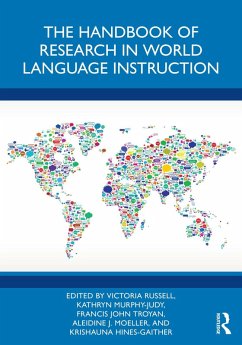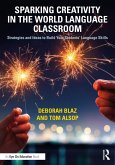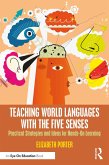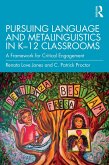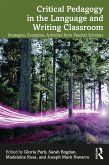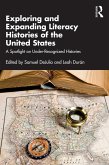The Handbook of Research in World Language Instruction (eBook, ePUB)
Redaktion: Russell, Victoria; Hines-Gaither, Krishauna; Moeller, Aleidine J.; John Troyan, Francis; Murphy-Judy, Kathryn


Alle Infos zum eBook verschenken

The Handbook of Research in World Language Instruction (eBook, ePUB)
Redaktion: Russell, Victoria; Hines-Gaither, Krishauna; Moeller, Aleidine J.; John Troyan, Francis; Murphy-Judy, Kathryn
- Format: ePub
- Merkliste
- Auf die Merkliste
- Bewerten Bewerten
- Teilen
- Produkt teilen
- Produkterinnerung
- Produkterinnerung

Hier können Sie sich einloggen

Bitte loggen Sie sich zunächst in Ihr Kundenkonto ein oder registrieren Sie sich bei bücher.de, um das eBook-Abo tolino select nutzen zu können.
This seminal handbook provides a comprehensive overview of the research on world language education and how that research can transform into effective and daily instructional practices for K-16 language teachers.
With contributions from leading scholars in the field, the volume addresses cutting-edge research, trends, and practice. Covering key topics in language education, the volume is organized in six sections: Teaching Methods and Approaches; Culture, Pragmatics, and Intercultural Communicative Competence; Assessment and Program Evaluation; Diversity, Equity, and Inclusion in the World…mehr
- Geräte: eReader
- mit Kopierschutz
- eBook Hilfe
- Größe: 6.9MB
![Sparking Creativity in the World Language Classroom (eBook, ePUB) Sparking Creativity in the World Language Classroom (eBook, ePUB)]() Deborah BlazSparking Creativity in the World Language Classroom (eBook, ePUB)29,95 €
Deborah BlazSparking Creativity in the World Language Classroom (eBook, ePUB)29,95 €![Representation, Inclusion and Social Justice in World Language Teaching (eBook, ePUB) Representation, Inclusion and Social Justice in World Language Teaching (eBook, ePUB)]() Representation, Inclusion and Social Justice in World Language Teaching (eBook, ePUB)41,95 €
Representation, Inclusion and Social Justice in World Language Teaching (eBook, ePUB)41,95 €![Teaching World Languages with the Five Senses (eBook, ePUB) Teaching World Languages with the Five Senses (eBook, ePUB)]() Elizabeth PorterTeaching World Languages with the Five Senses (eBook, ePUB)28,95 €
Elizabeth PorterTeaching World Languages with the Five Senses (eBook, ePUB)28,95 €![Pursuing Language and Metalinguistics in K-12 Classrooms (eBook, ePUB) Pursuing Language and Metalinguistics in K-12 Classrooms (eBook, ePUB)]() Renata Love JonesPursuing Language and Metalinguistics in K-12 Classrooms (eBook, ePUB)38,95 €
Renata Love JonesPursuing Language and Metalinguistics in K-12 Classrooms (eBook, ePUB)38,95 €![Literacies in the Platform Society (eBook, ePUB) Literacies in the Platform Society (eBook, ePUB)]() Literacies in the Platform Society (eBook, ePUB)42,95 €
Literacies in the Platform Society (eBook, ePUB)42,95 €![Critical Pedagogy in the Language and Writing Classroom (eBook, ePUB) Critical Pedagogy in the Language and Writing Classroom (eBook, ePUB)]() Critical Pedagogy in the Language and Writing Classroom (eBook, ePUB)39,95 €
Critical Pedagogy in the Language and Writing Classroom (eBook, ePUB)39,95 €![Exploring and Expanding Literacy Histories of the United States (eBook, ePUB) Exploring and Expanding Literacy Histories of the United States (eBook, ePUB)]() Exploring and Expanding Literacy Histories of the United States (eBook, ePUB)41,95 €
Exploring and Expanding Literacy Histories of the United States (eBook, ePUB)41,95 €-
-
-
With contributions from leading scholars in the field, the volume addresses cutting-edge research, trends, and practice. Covering key topics in language education, the volume is organized in six sections: Teaching Methods and Approaches; Culture, Pragmatics, and Intercultural Communicative Competence; Assessment and Program Evaluation; Diversity, Equity, and Inclusion in the World Language Classroom; Technology Integration and Online Language Teaching and Learning; and Key Issues in World Language Instruction, including advocacy, teacher recruitment and retention, and professional development.
This handbook is an essential text for all scholars, researchers, and educators in world languages.
Dieser Download kann aus rechtlichen Gründen nur mit Rechnungsadresse in A, B, BG, CY, CZ, D, DK, EW, E, FIN, F, GR, HR, H, IRL, I, LT, L, LR, M, NL, PL, P, R, S, SLO, SK ausgeliefert werden.
- Produktdetails
- Verlag: Taylor & Francis eBooks
- Seitenzahl: 668
- Erscheinungstermin: 5. Juni 2025
- Englisch
- ISBN-13: 9781040348956
- Artikelnr.: 74056042
- Verlag: Taylor & Francis eBooks
- Seitenzahl: 668
- Erscheinungstermin: 5. Juni 2025
- Englisch
- ISBN-13: 9781040348956
- Artikelnr.: 74056042
- Herstellerkennzeichnung Die Herstellerinformationen sind derzeit nicht verfügbar.
1. Teaching Approaches and Methods in World Language Instruction
Victoria Russell
2. ACTFL's Core Practices: The Six Pillars of Effective Language Teaching
Kate McCrea Francis and Celia Chomón Zamora
3. Target Language Comprehensibility in the World Language Classroom
Krista Chambless and Christina Huhn
4. Differentiated Instruction: Meeting Student Needs
Leslie Baldwin
5. Project-Based Language Learning: Evolution, Design Features, and
Research Insights
Julio C. Rodríguez
6. Literacy-Based Approaches to World Language Instruction
Bruna Sommer-Farias and Myriam Abdel-Malek
7. Supporting Heritage Learners in the Classroom and Beyond
Maria M. Carreira
8. Early Language Learning in Dual Language Bilingual Education and
Traditional Elementary Classrooms
Katherine Barko-Alva and Paola Mendizábal
9. Experiential Learning: Engaging Students in Real-World Language Use
Todd A. Hernández with Paul A. García
Part 2: Culture, Pragmatics, and Intercultural Communicative Competence
10. Navigating the Multifarious Waters of Intercultural Communication with
Learner-Centered Classroom Tasks
Aleidine J. Moeller and Stephanie W. P. Knight
11. Centering Communication in ICC: Fostering Target Language Use with
Critical Cultural Inquiry
Paula Garrett-Rucks
12. Embrace the Unknown: Interlanguage Pragmatics through Games and Play
Julie Sykes, Sébastien Dubreil, and Stephanie W. P. Knight
13. Assessing Intercultural Capability
Angela Scarino, Michelle Kohler, and Anthony J. Liddicoat
14. The Why and How of Teaching for Social Justice and Intercultural
Citizenship: Experiences of Early Adopters
Manuela Wagner, Terry A. Osborn, and Violet Affleck
15. Developing Critical Cultural Awareness and Critical Consciousness in
World Language Classrooms
Theresa Catalano and Inoussa Malgoubri
16. Intercultural Communicative Competence and Intercultural Citizenship
Dorie Conlon and Michael Byram
17. Perspective-Making and Its Potential in Intercultural Learning
Erin Kearney and Tasha Austin
Part 3: Assessment and Program Evaluation
18. Assessment Competence in World Language Education
Lynda Taylor and Beverly Baker
19. Proficiency Testing in World Language Education
J. Dylan Burton and Paula Winke
20. Performance Assessment in World Language Education
Francis John Troyan, Jason Martel, and Anna Zaitseva
21. Student Feedback and Uptake in World Language Education
Bobby Hobgood
22. Dynamic Assessment in World Language Education
Ali Kushki and Kristin J. Davin
23. Program Evaluation in World Language Education
Margaret E. Malone and Meg Montee
Part 4: Diversity, Equity, and Inclusion in the World Language Classroom
24. The Antiracist World Language Classroom in the Midst of Opposing DEI
Legislations
Krishauna Hines-Gaither and Cécile Accilien
25. Educator Agency in World Language Education: A Movement toward
Diversity, Equity and Inclusion
Cassandra Glynn and Beth Wassell
26. Transdisciplinary Curricular Frameworks for Justice-Centered Pedagogies
in the World Language Classroom
L.J. Randolph Jr.
27. Teaching Towards Gender Justice: Considerations in Materials Design,
Selection, and Use
Kris Aric Knisely
28. Making Invisible LGBTQIA+ Students Visible in World Language Curricula
Paul A. García and James E. Coda
29. Supporting Neurodiverse Students in the Secondary World Language
Classroom
Meredith McDonald White, Jenniffer Whyte, and Kimberly M. Winslow
30. An Antiracist Approach to World Language Assessment: Making the
Invisible Visible
Trina Philpot-Montaño
Part 5: Technology Integration and Online Language Teaching and Learning
31. Technology Integration in Europe: An Experiential Approach
Ursula Stickler and Regine Hampel
32. OER and OEP for Second Language Learning and Teaching
Carl S. Blyth and Joshua J. Thoms
33. Differentiation and Retention: How Flipped Lessons Support Student
Needs
Lauren Rosen
34. Building Connections among World Language Learners with Virtual
Exchange
Deniz Gökçora and Raymond Oenbring
35. Supporting Less Commonly Taught and Indigenous Languages through
Technology Integration and Online Language Learning
Luca Giupponi, Emily Heidrich Uebel, Felix A. Kronenberg, and Danielle
Steider
36. The Maker Movement in World Language Education
Gillian Lord
37. The Fine Line between Digital Literacy and Academic Dishonesty in
Online World Language Instruction
Errol O'Neill
Part 6: Key Issues in World Language Instruction
38. Seal of Biliteracy Implementation in World Language Programs
Kristin J. Davin and Amy J. Heineke
39. Engaging World Language Educators in Continuing Professional
Development
Rebecca Kanak Fox, Kelley E. Webb, and Joan Kang Shin
40. The World Language Teacher Shortage and Teacher Retention: Insight and
Recommendations
Pete Swanson and Jason Fischbach
41. The World Language edTPA: Lessons Learned from a National Certification
Assessment
Susan A. Hildebrandt
42. Indigenous Language Revitalization: Dual Language Immersion in Practice
Brandon T. Locke
43. Preparing Students for a Career in Languages: Why World Language
Education Programs Matter
Patricia W. Cummins
Conclusion: Future Directions in World Language Instruction
Pamela M. Wesely, Celia Chomón Zamora, Pablo Muirhead, and Victoria Russell
1. Teaching Approaches and Methods in World Language Instruction
Victoria Russell
2. ACTFL's Core Practices: The Six Pillars of Effective Language Teaching
Kate McCrea Francis and Celia Chomón Zamora
3. Target Language Comprehensibility in the World Language Classroom
Krista Chambless and Christina Huhn
4. Differentiated Instruction: Meeting Student Needs
Leslie Baldwin
5. Project-Based Language Learning: Evolution, Design Features, and
Research Insights
Julio C. Rodríguez
6. Literacy-Based Approaches to World Language Instruction
Bruna Sommer-Farias and Myriam Abdel-Malek
7. Supporting Heritage Learners in the Classroom and Beyond
Maria M. Carreira
8. Early Language Learning in Dual Language Bilingual Education and
Traditional Elementary Classrooms
Katherine Barko-Alva and Paola Mendizábal
9. Experiential Learning: Engaging Students in Real-World Language Use
Todd A. Hernández with Paul A. García
Part 2: Culture, Pragmatics, and Intercultural Communicative Competence
10. Navigating the Multifarious Waters of Intercultural Communication with
Learner-Centered Classroom Tasks
Aleidine J. Moeller and Stephanie W. P. Knight
11. Centering Communication in ICC: Fostering Target Language Use with
Critical Cultural Inquiry
Paula Garrett-Rucks
12. Embrace the Unknown: Interlanguage Pragmatics through Games and Play
Julie Sykes, Sébastien Dubreil, and Stephanie W. P. Knight
13. Assessing Intercultural Capability
Angela Scarino, Michelle Kohler, and Anthony J. Liddicoat
14. The Why and How of Teaching for Social Justice and Intercultural
Citizenship: Experiences of Early Adopters
Manuela Wagner, Terry A. Osborn, and Violet Affleck
15. Developing Critical Cultural Awareness and Critical Consciousness in
World Language Classrooms
Theresa Catalano and Inoussa Malgoubri
16. Intercultural Communicative Competence and Intercultural Citizenship
Dorie Conlon and Michael Byram
17. Perspective-Making and Its Potential in Intercultural Learning
Erin Kearney and Tasha Austin
Part 3: Assessment and Program Evaluation
18. Assessment Competence in World Language Education
Lynda Taylor and Beverly Baker
19. Proficiency Testing in World Language Education
J. Dylan Burton and Paula Winke
20. Performance Assessment in World Language Education
Francis John Troyan, Jason Martel, and Anna Zaitseva
21. Student Feedback and Uptake in World Language Education
Bobby Hobgood
22. Dynamic Assessment in World Language Education
Ali Kushki and Kristin J. Davin
23. Program Evaluation in World Language Education
Margaret E. Malone and Meg Montee
Part 4: Diversity, Equity, and Inclusion in the World Language Classroom
24. The Antiracist World Language Classroom in the Midst of Opposing DEI
Legislations
Krishauna Hines-Gaither and Cécile Accilien
25. Educator Agency in World Language Education: A Movement toward
Diversity, Equity and Inclusion
Cassandra Glynn and Beth Wassell
26. Transdisciplinary Curricular Frameworks for Justice-Centered Pedagogies
in the World Language Classroom
L.J. Randolph Jr.
27. Teaching Towards Gender Justice: Considerations in Materials Design,
Selection, and Use
Kris Aric Knisely
28. Making Invisible LGBTQIA+ Students Visible in World Language Curricula
Paul A. García and James E. Coda
29. Supporting Neurodiverse Students in the Secondary World Language
Classroom
Meredith McDonald White, Jenniffer Whyte, and Kimberly M. Winslow
30. An Antiracist Approach to World Language Assessment: Making the
Invisible Visible
Trina Philpot-Montaño
Part 5: Technology Integration and Online Language Teaching and Learning
31. Technology Integration in Europe: An Experiential Approach
Ursula Stickler and Regine Hampel
32. OER and OEP for Second Language Learning and Teaching
Carl S. Blyth and Joshua J. Thoms
33. Differentiation and Retention: How Flipped Lessons Support Student
Needs
Lauren Rosen
34. Building Connections among World Language Learners with Virtual
Exchange
Deniz Gökçora and Raymond Oenbring
35. Supporting Less Commonly Taught and Indigenous Languages through
Technology Integration and Online Language Learning
Luca Giupponi, Emily Heidrich Uebel, Felix A. Kronenberg, and Danielle
Steider
36. The Maker Movement in World Language Education
Gillian Lord
37. The Fine Line between Digital Literacy and Academic Dishonesty in
Online World Language Instruction
Errol O'Neill
Part 6: Key Issues in World Language Instruction
38. Seal of Biliteracy Implementation in World Language Programs
Kristin J. Davin and Amy J. Heineke
39. Engaging World Language Educators in Continuing Professional
Development
Rebecca Kanak Fox, Kelley E. Webb, and Joan Kang Shin
40. The World Language Teacher Shortage and Teacher Retention: Insight and
Recommendations
Pete Swanson and Jason Fischbach
41. The World Language edTPA: Lessons Learned from a National Certification
Assessment
Susan A. Hildebrandt
42. Indigenous Language Revitalization: Dual Language Immersion in Practice
Brandon T. Locke
43. Preparing Students for a Career in Languages: Why World Language
Education Programs Matter
Patricia W. Cummins
Conclusion: Future Directions in World Language Instruction
Pamela M. Wesely, Celia Chomón Zamora, Pablo Muirhead, and Victoria Russell
